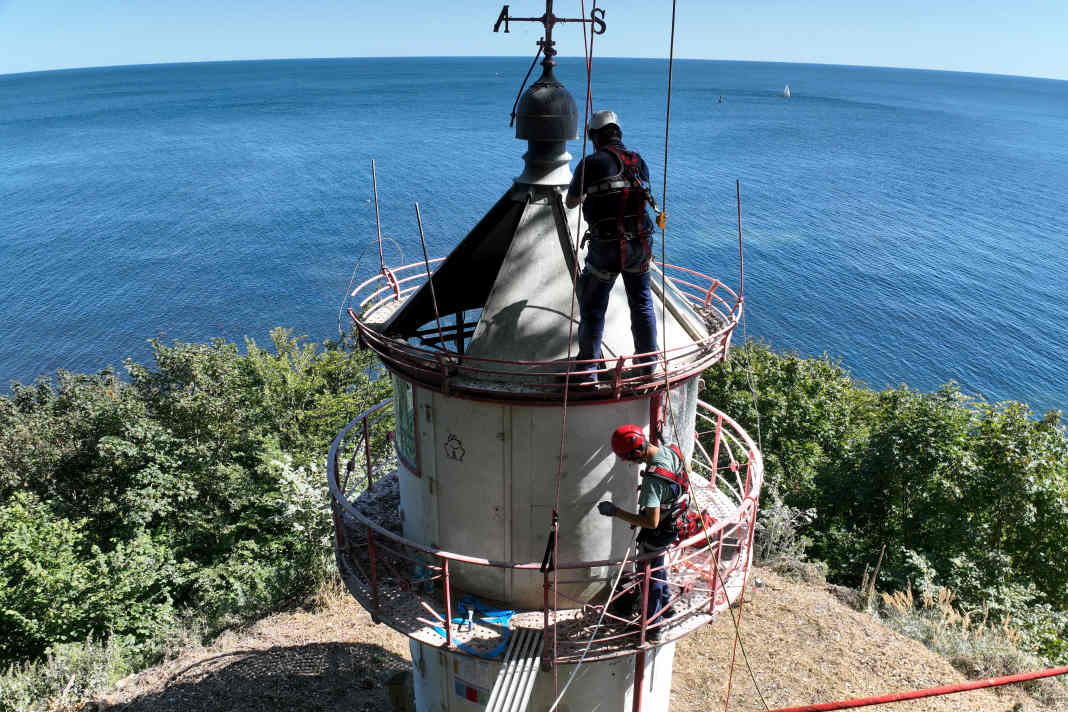





The tower, built in 1904, was first dismantled into individual parts and then transported away using a Super Puma heavy-lift helicopter. The structure weighed a total of seven tonnes. The Baltic Sea Waterways and Shipping Authority (WSA) explained that the spectacular operation on the chalk cliff north of Sassnitz was unavoidable.
The coastline is increasingly receding due to erosion, which exposed the historic structure to a serious risk of falling. According to Stefan Grammann, head of the WSA Baltic Sea, the dismantling was a particular challenge due to the steep slope in the middle of the national park, which was successfully mastered. Weeks of preparation were required to carry out the work safely on the exposed cliffs.
Lighthouse to be deleted from nautical charts
The "Kollicker Ort" lighthouse served as a so-called cross-marker light for Sassnitz harbour and as an orientation light for Prorer Wiek until the end. The white tower consisted of 24 cast-iron elements and was six metres high. It also had a characteristic conical copper roof with a wind rose. The beacon was technically decommissioned at the end of July. Mariners were asked by the WSA to remove the beacon from their charts. As a replacement, three cardinal buoys were laid out off the coast to provide orientation.
Other interesting articles on this topic
"Roter Sand" lighthouse also threatened with collapse
For over 140 years, the "Roter Sand" lighthouse has stood steadfast in the German Bight, around 30 nautical miles north of Bremerhaven. It is considered the oldest offshore structure in the world and combines technical history and wanderlust. It was first built directly on the high seas between 1882 and 1885. A heavy steel shell, called a caisson, was filled with concrete and masonry and anchored deep in the sandy seabed. It served emigrants as a final greeting from home and as a widely visible navigation aid for those sailing through the sands of the Weser estuary until its light was extinguished in 1964. Despite its harsh location, the tower with its red and white stripes, black base and caps looks proud and defensive, in the colours of the German Empire. The shape is reminiscent of castle construction, but the roof resembles a pointed cap with bay windows and cones that make it look like a fairy tale. This contrast fascinates many people. After it was decommissioned, the "Roter Sand" lighthouse became a popular excursion destination. In the meantime, it was even possible to spend the night in the historic rooms and experience the unique atmosphere in the middle of the sea.
"Red sand" to move
However, the harsh offshore conditions of the North Sea have taken their toll on the tower. The caisson, the tower's robust foundation, is now so badly damaged that there is a risk of it collapsing. Experts from the German Foundation for Monument Protection decided to take an emotional and logistically challenging step: the upper, culturally significant segment of the 53-metre-high, 70-tonne structure is to be detached using a heavy-duty pontoon and special crane and carefully brought ashore. This will probably be one of the most complex maritime salvage operations ever carried out on the German North Sea coast. The complex transport route to the coast requires not only the use of specialised cranes and floating heavy-duty platforms, but also favourable weather and tidal conditions. The historic plinth must remain in place for technical and conservation reasons.
Visit the lighthouse while you still can!
Until then, lovers of maritime history can still experience the tower in its old location. For pleasure boaters from the Jade and Weser rivers, the sight of the landmark is commonplace. But even those who live or sail further afield have the opportunity to visit the tower. Numerous trips are organised as part of the SAIL 2025 in Bremerhaven - be it on traditional ships or sporty on a Bénéteau 473 Oceanis Clipper at "Sailing partner North Sea". One journey to Heligoland from Bremerhaven also leads past this landmark. If you prefer a cosy atmosphere, you can take a NDR documentary about the journey to the Weser estuary and the tower.

